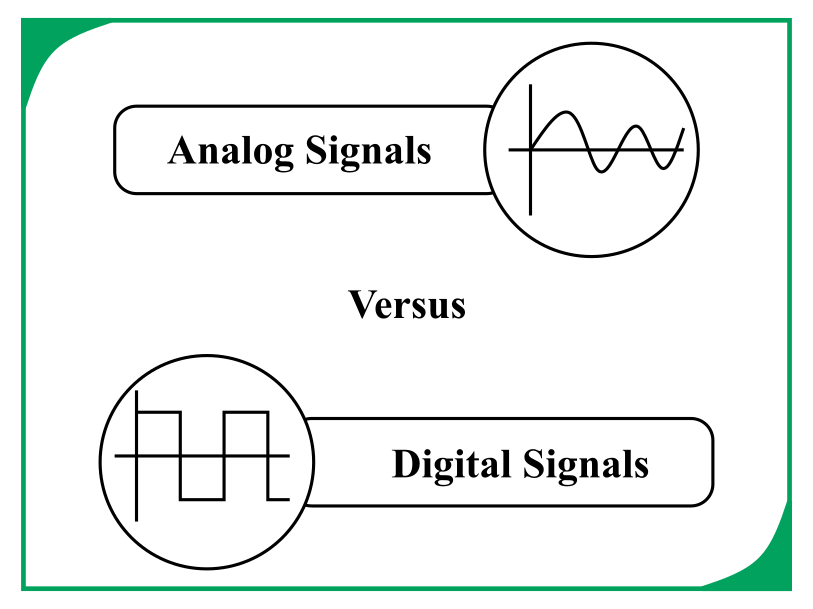Analog vs Digital
In the world of electronics and telecommunications, signals are the fundamental carriers of information. They can be broadly categorized into two types: analog and digital signals. Understanding the difference between these two signal types is crucial, as they play a pivotal role in various technologies.
In this article, Aim Dynamics will delve into the distinctions between analog and digital signals, shedding light on their characteristics, applications, and more.

What is an Analog Signal?
Analog signals are continuous, time-varying waveforms that represent information in a manner analogous to the original data. These signals can take on any value within a given range and are commonly used in devices like radios, televisions, and vinyl record players. Analog signals can be likened to a smoothly flowing river, with no discrete jumps in value.
Characteristics of Analog Signals
- Continuous waveforms
- Infinite range of values
- Susceptible to interference and noise
- High fidelity in reproducing original information
- Smooth transitions between values
What is a Digital Signal?
In contrast, digital signals are discrete, quantized representations of data. They are characterized by distinct values and abrupt transitions. Digital signals are commonly used in modern electronic devices such as smartphones, computers, and digital cameras. Think of them as a staircase with clearly defined steps.
Characteristics of Digital Signals
- Discrete values (usually 0 and 1)
- Limited range of values
- Resistant to noise and interference
- High accuracy in data transmission and storage
- Stepwise transitions between values
Key Differences
Representation
Analog signals represent data through continuous fluctuations, while digital signals employ discrete values (usually binary) to represent information. This fundamental difference has significant implications for how data is processed and transmitted.
Noise
Analog signals are highly susceptible to noise, which can distort the original information. Digital signals, on the other hand, are more robust against noise, as they rely on distinct values that can be accurately reconstructed.
Accuracy
Digital signals excel in maintaining data accuracy. They are less prone to signal degradation during transmission, ensuring that the received data matches the transmitted data. Analog signals may lose accuracy due to noise and signal degradation.
Transmission
Analog signals are traditionally used for long-distance transmission, as they can travel significant distances without the need for frequent regeneration. Digital signals, while better at preserving data integrity, may require signal boosting for extended transmission distances.
Applications of Analog Signals
Analog signals find applications in various areas, including:
- AM and FM radio broadcasting
- Analog television
- Vinyl record players
- Traditional telephony systems
Applications of Digital Signals
Digital signals are prevalent in modern technology, including:
- Digital TV broadcasting
- Smartphones
- Computers
- Digital cameras
FAQs
1) Which is more resistant to noise, analog or digital signals?
Digital signals are more resistant to noise compared to analog signals due to their discrete, easily distinguishable values.
2) Can analog and digital signals be converted into each other?
Yes, analog signals can be digitized, and digital signals can be converted to analog signals through various devices and techniques.
3) Are there situations where analog signals are preferred over digital signals?
Yes, analog signals are preferred in situations where continuous data representation and long-distance transmission are essential, such as in AM/FM radio broadcasting.
4) What is the advantage of using digital signals in data storage?
Digital signals are advantageous in data storage because they can be easily replicated and do not degrade over time, ensuring data accuracy.
5) Why do modern devices like smartphones and computers use digital signals extensively?
Digital signals are used in modern devices because of their accuracy, resistance to noise, and compatibility with digital processing, making them ideal for advanced technologies.
Conclusion
In summary, the difference between analog and digital signals lies in their representation, susceptibility to noise, accuracy, and transmission capabilities. Analog signals are like continuous rivers, whereas digital signals resemble stepped staircases.
Both signal types have their unique applications in technology, and understanding their disparities is vital for selecting the right signal for a given purpose.
You Might Also Like: Poe switch | Industrial Power over Ethernet Switches








